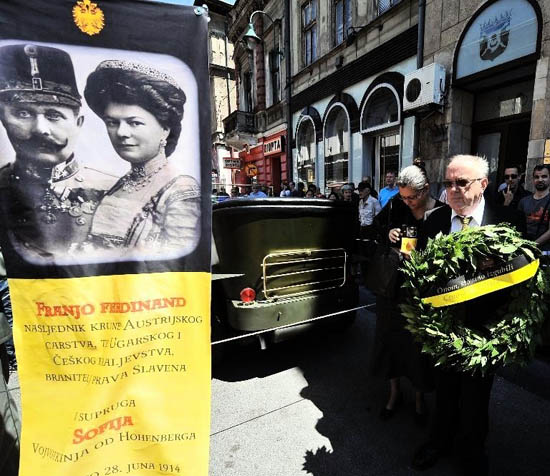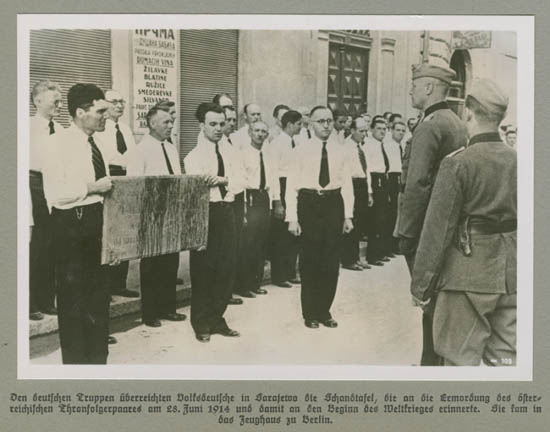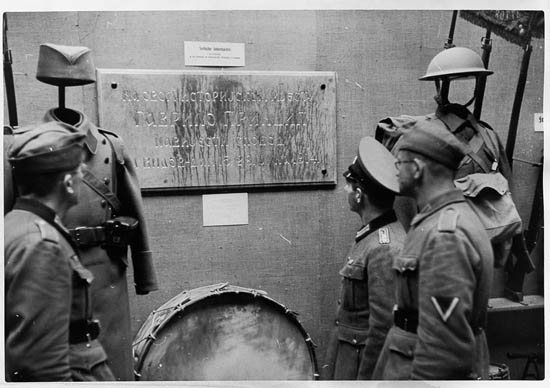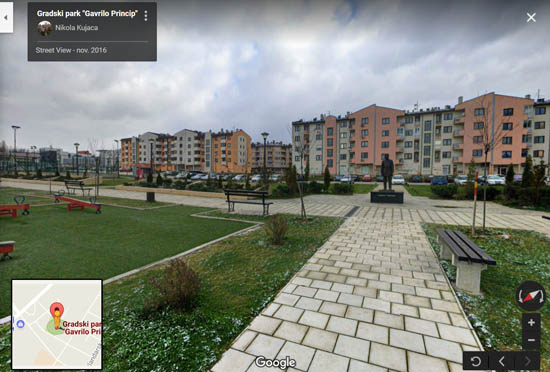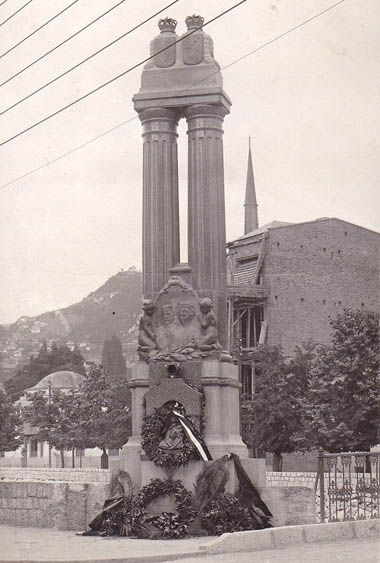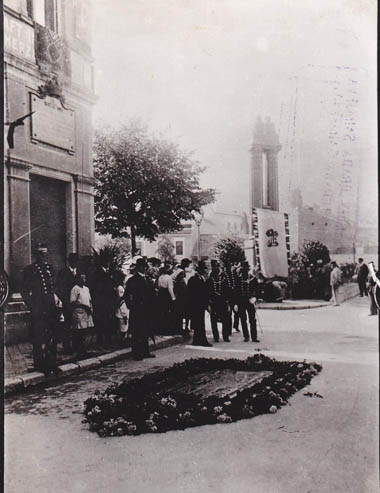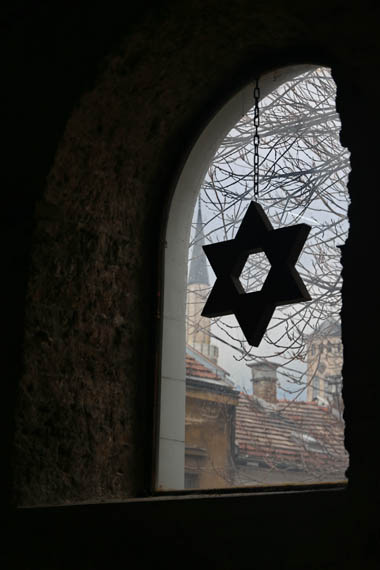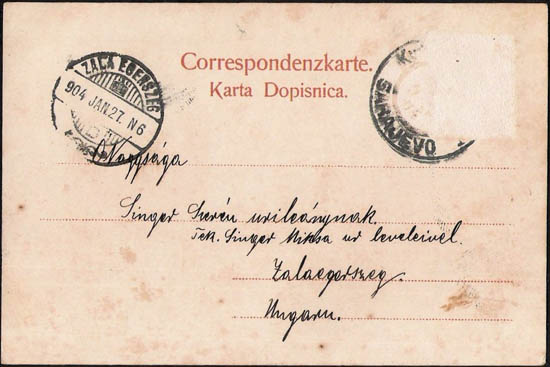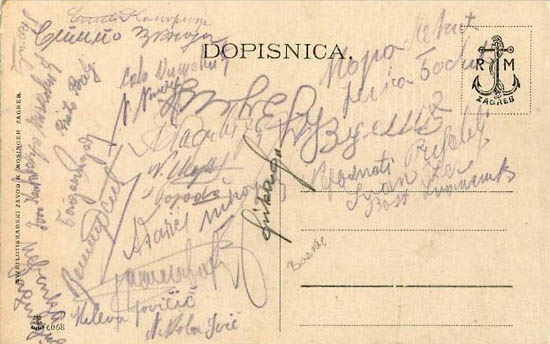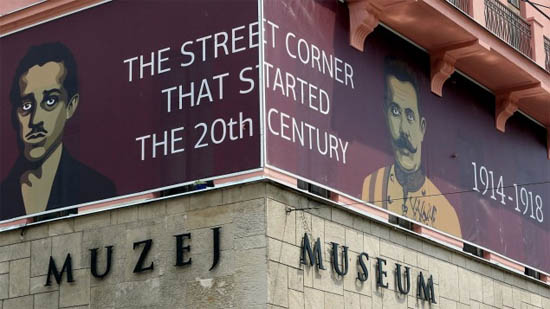
In fact, the removal of the plaque was considered so important by the German official newsreel Deutsche Wochenschau, that they dedicated an entire half minute to it out of the twenty-four-minute broadcast of the truly glamorous events of the week. By clicking on it, the video starts right at 11:38, at the beginning of the scene.
“In Sarajewo. Hier wurde am 28en Juni 1914 der österreichische Tronfolger Erzherzog Franz Ferdinand durch das feige Attentat eines serbischen Studenten niedergestreckt. Diese Schüsse waren das Signal zum Weltkrieg. – Die Marmortafel, die diesem Ort von Volksdeutschen entfernt, und dem deutschem Wehrmacht übergeben. Sie trägt die Inschrift: »An dieser historischen Stätte erkämpfte Gavrilo Princip Serbien die Freiheit.« Der Führer überwiest die Tafel der Berliner Zeughaus.”
“Sarajevo. On June 28, 1914, the infamous terror attack of a Serbian student killed Austrian Crown Prince Franz Ferdinand. This gunshot gave the signal to the Great War. – This marble plaque was removed by the Volksdeutsche and handed over to the German army. Its inscription: «In this historic place, Gavrilo Princip achieved freedom for Serbia.» The Führer forwarded the plaque to the Zeughaus in Berlin.”
The newsreel emphasizes that the plaque was removed not by the army, but by the Volksdeutsche, the local ethnic Germans, and it was they who then handed it to the army. However, the spontaneity of the dozen of young people, dressed in flawless white shirts and ties, and performing a well-choreographed little march, is quite questionable. Not to mention that the field musicians and officers of the Wehrmacht are assisting in this action, obviously just as spontaneously. And if we also know that the pictures were taken by Heinrich Hoffmann, Hitler’s personal photographer, who then immediately boarded Hitler’s private train Sonderzug Amerika, especially sent for the plaque, to photograph the next day the Führer, celebrating his fifty-second birthday in Mönichkirchen, as he is intensely looking at the plaque, then it will be clear that it was a well-planned and prepared symbolic event.
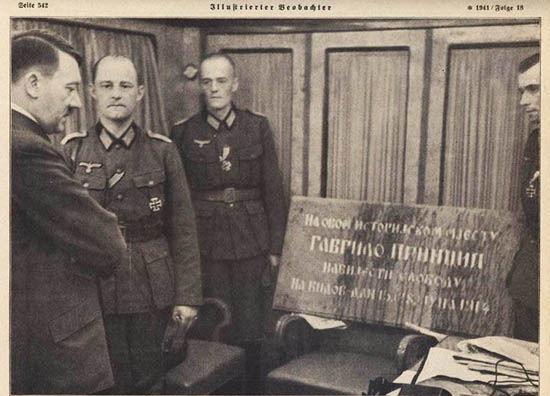
Hitler is also beholding extremely spontaneously the plaque surrounded by two and half zombies. We know that only Hoffmann was allowed to take photos of him, and only while posing, in poses worthy of a great statesman. These poses were borrowed from the topos repository created by classical and romantic painting and sculpture, which also offer us a clue to understanding them. The one we see here is “the great general contemplating the ruins of Rome” pose. Which also suggests that this plaque meant more to him than merely spoils of war from an unnatural state created by Versailles.
Hitler agreed with Franz Ferdinand’s removal from the throne, even though he condemned the assassins. The Slavic-friendly crown prince, who had a Czech consort, meant to him and to his associates the danger of a compromise with the Slavs and the diminution of the weight of the German element. It is no wonder that he celebrated with relief on Munich’s Odeonplatz the war that settles accounts with Serbia and Russia threatening the German Lebensraum. By accident, this moment was photographed by Hoffmann, who, twenty years later, found the future Führer it in, at his request. No matter whether the figure is really the young Adolf, or, as some say, some retouching by Hoffmann was also necessary to make the identification. The point is that Hitler wanted be in that picture, he wanted to be at the starting point of the glorious German Sturm. It was the zero point of the Sarajevo pistol shot that launched him and the German people on the right track, and now that this track – despite the humiliation of Versailles and through its obliteration – would soon reach its zenith with the overcoming of Russia, the Führer looks back at this starting point when contemplating the Princip plaque.
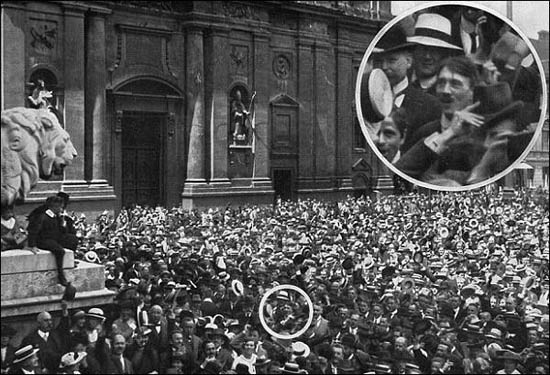
In 1930 the Yugoslav state, by placing a plaque on the spot of the Princip attempt – albeit setting it as a private initiative – with the inscription “На овом историјском мјесту Гаврило Принцип навијести слободу на Видов-дан 15. јуна 1914” – “From this historical place Gavrilo Princip brought us freedom on St. Vitus’ Day, 15 June 1914” (that is, on the 28th of the Gregorian calendar), managed to achieve the outbreaks of not only its former World War enemies, but also of its own allies. That Deutsche Allgemeine Zeitung calls it a “monstrous and intolerable provocation”, is just natural from the German side. But also London Times wrote, that the plaque immortalizes “an act which was the immediate cause of the Great War, of its attendant horrors, and of the general suffering which has been its sequel”. Churchill, in his contemporary The Unknown War calls it the monument of infamy, which, erected by Princip’s fellow countrymen, “records his infamy and their own”. And according to the contemporary British historian Robert William Seton-Watson, the plaque “was an affront to all right-thinking people”.
However, we cannot understand the real cause of the establishing of the plaque if we do not know the myth that it fits within. The clue is offered by the seemingly unnecessary archaism of Vidovdan, St. Vitus’ day, in the text. On this day, 15 June 1318, the whole Serb nation, led by Prince Lazar, was martyred on the plane of Kosovo, confronting the Ottoman army to the last warrior. This is the zero point of Serbian history. One has to get back here, and here one has to restart history, which at that point took a regrettably wrong turn. This is the so-called Kosovo Myth, which was coined by 19th-c. Serbian romanticism, and to which we can lead back all the 20th-century Balkan wars that started from Belgrade. To kill a tyrant on St. Vitus’ Day is an archetypal act, as was done by the legendary Serbian warrior Miloš Obilić, who struck the Sultan after his victory. And vice versa: if a Serbian warrior kills someone on Vidovdan, it symbolically attests that he was a tyrant. Princip’s Vidovdan bullet in one moment produced the archetypal constellation required by the Serbian military leadership to represent the fight for the re-devision of the Balkans as a sacred national war. From then on, the struggle for Bosnia was not just a dog-fight over the territories left by the Turks, but a necessary historical act leading to the correction of national history, which had taken a wrong turn in 1389. This zero point and this myth was faced with the myth and zero point of the Führer contemplating it in the railway wagon in Mönchkirchen.
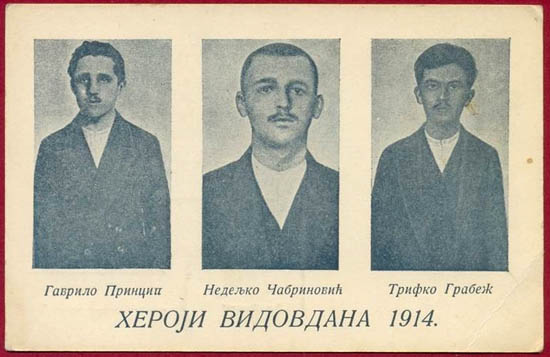 Princip and his fellow conspirators as Vinovdan heroes. Below: The “chapel of the Vinovdan hroes”, erected upon Princip’s ashes, in Sarajevo’s old Orthodox cemetery
Princip and his fellow conspirators as Vinovdan heroes. Below: The “chapel of the Vinovdan hroes”, erected upon Princip’s ashes, in Sarajevo’s old Orthodox cemetery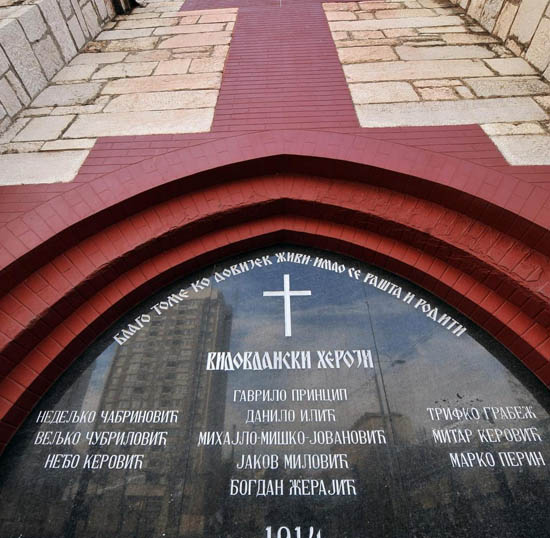
The plaque was then moved to the Zeughaus in Berlin, which was then a military museum called Arsenal. Here, a huge exhibition of the symbolic booty was organized, with Princip’s plaque in the middle. They also brought here the French rail car, in which in 1918 the German capitulation was signed, thus washing away the shame of Versailles. The building is today Deutsches Historisches Museum, where similar objects still often pop up, now of course as exhibition objects. Like the Zagreb bronze plaque, which attempted to give a new consciousness to the young South Slavic state by stamping the Hungarian coat of arm under its figures’ feet.
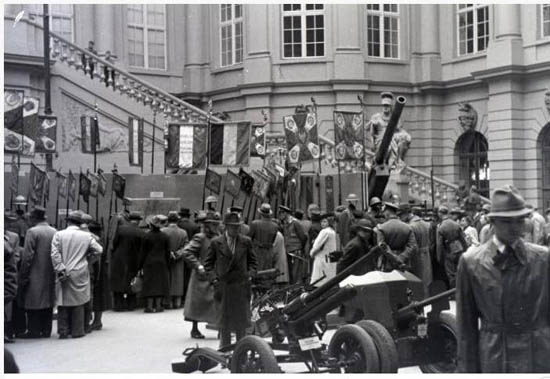
During the siege of Berlin, the plaque was destroyed together with the German myth. In Sarajevo, the Yugoslav partisans replaced it on 7 May 1945, a day before the German capitulation, with this inscription: “With eternal thanks to Gavrilo Princip and his comrades fighting against the German invasion.” For now, the Serbian myth gained the upper hand, in a new, popular tuning. In 1953, when the building was converted into a museum of the Young Bosnia movement, which had organized the assassination, a new plaque was set up with a new text: “On June 28, 1914, from this place Gavrilo Princip expressed with his pistol shot the people’s protest and centuries-old aspirations for freedom.” This plaque disappeared between 1992 and 1996, when the people of Sarajevo also expressed with machine gun shots from this place their aspirations for freedom and protest against the tyranny of Serbian nationalism, keeping the city under a bloody siege. Today it only says in Bosnian and English: “From this place on 28 June 1914 Gavrilo Princip assassinated the Austro-Hungarian throne Franz Ferdinand and his wife Sofia.”
On 28 June 2014, when this plaque was inaugurated, another monument was also solemnly set up in Sarajevo. The small square is located at the westernmost end of Sarajevo, which is nevertheless called East Sarajevo. This is the part of the town where the Serbs moved out during the siege, and where, after the war, new housing estates were built for them from international aid. There are no physical boundaries between the two parts of the city, yet there is virtually no contact and no public transport between them. Here, a new, heroic statue of Gavrilo Princip was set up, and at the same time one of the first public spaces of the new district in formation was also named Gavrilo Princip Park. The myth lives on.
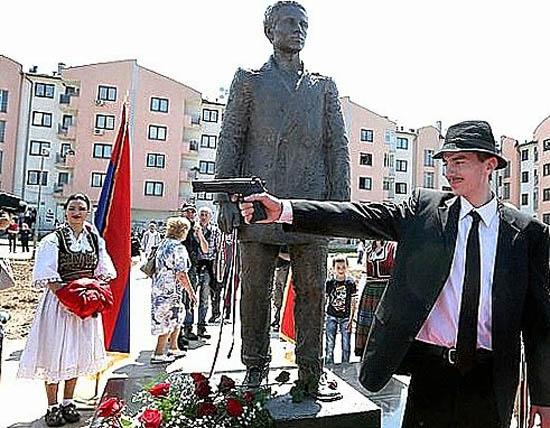
However, the first souvenirs of the assassination were much earlier than the 1930 memorial plaque. Already a hundred years ago, the local paper shops entered into the service of catastrophe tourism, and immediately started publishing picture postcards, which do not merely represent the Latin Bridge and its environs as a city view, but rather as the scene of the assassination, sometimes marking the exact spot with a small cross.
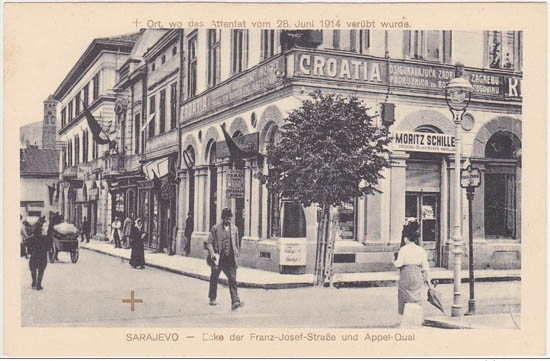
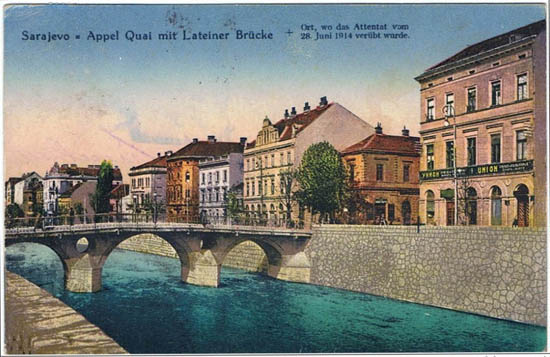
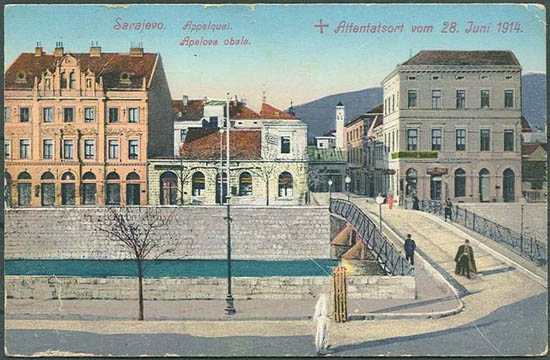
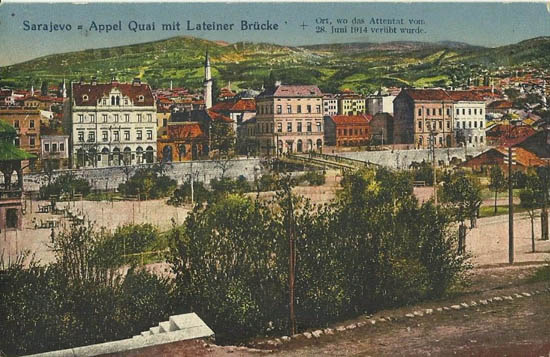
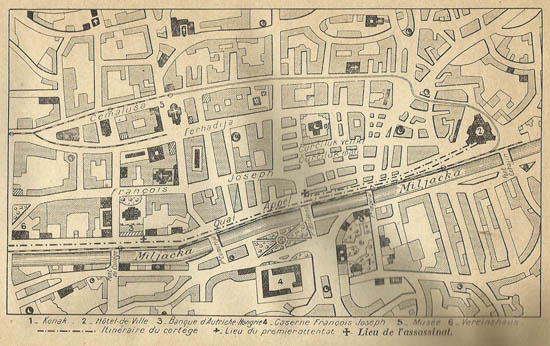
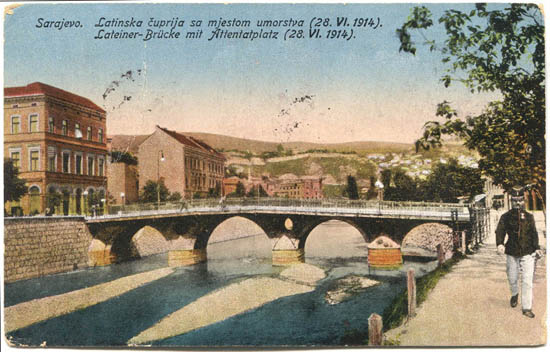
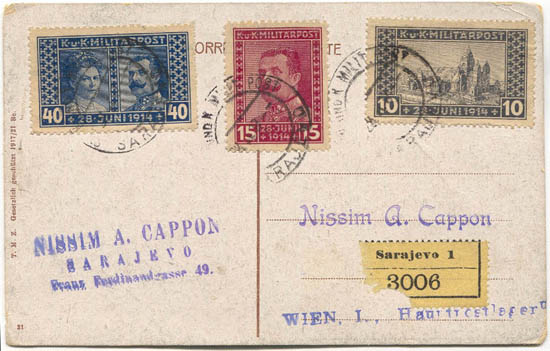 The souvenir postcards were usually provided with the Franz Ferdinand memorial stamps, which represented, besides the princely consorts, the Sarajevo Basilica, planned but never realized in their memory (see below).
The souvenir postcards were usually provided with the Franz Ferdinand memorial stamps, which represented, besides the princely consorts, the Sarajevo Basilica, planned but never realized in their memory (see below).And in 1917, on the third anniversary of the attempt, the first plaque appeared on the spot, marking the location for all subsequent plaques. This plaque was set up by the Austro-Hungarian government on Moritz Schiller’s deli, from which Princip stepped out to shoot the crown prince. The only Bosnian-language plaque with cross and imperial crown said: “In this place, Crown Prince Franz Ferdinand and his consort, Duchess Sophie Hohenberg suffered a martyr’s death at an assassin’s hand.”
 The plaque in front view, and seen from the quay and from Franz Josef street.
The plaque in front view, and seen from the quay and from Franz Josef street. Last photo: the scaffolding used to affix the plaque.

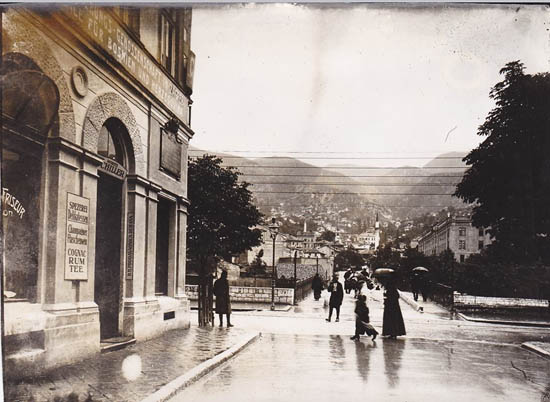

Already in 1916, the government of Bosnia-Herzegovina announced a competition for a grand martyr’s monument of the princely couple. It had a Hungarian winner, the excellent Art Nouveau sculptor and architect Jenő Bory (1879-1959), later rector of the Hungarian Academy of Fine Arts, who in January 1915 was commissioned to Sarajevo as a military engineer. Here Pater Puntigam, the director of the archbishop’s seminary, and the chief promoter of the Archduke’s cult, showed him the Archduke’s bloody shirt, and introduced him to the conception of the story which was to be visualized in the memorial.
Since there was no room for a monument in the narrow Franz Josef Street, only a 2×1-meter cast steel plate was sunk into the pavement, with the Latin inscription: “Hoc loco die 28. Junie 1914. vitam et sanquinem fuderunt pro Deo et patria Franciscus Ferdinandus archidux eiusque uxor ducissa Sophia de Hohenberg.” (“In this place Crown Prince Franz Ferdinand and his wife, Duchess Sophie Hohenberg gave their lives and blood for God and the homeland.”) Probably this sunken panel gave the idea of that much later, post-1953 monument, which sank the assassin’s footprints into the pavement of the walkway.
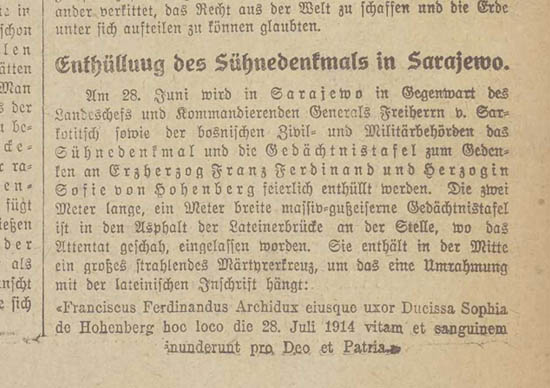 No legible photo of the sunken panel has survived, and different sources remember slightly different texts. This one is from Belgischer Kurier, a local version of Deutsche Kurier published in occupied Belgium.
No legible photo of the sunken panel has survived, and different sources remember slightly different texts. This one is from Belgischer Kurier, a local version of Deutsche Kurier published in occupied Belgium.The actual monument was set up on the opposite side of the quay, at the head of the Latin Bridge opposite the house. Two tall columns held the bronze relief of the princely couple, with a small Pietà statue and an eternal flame under it. For the sake of symmetry, a semicircular marble bench was also built at the other bridgehead, where it was possible to meditate on the historical scene.
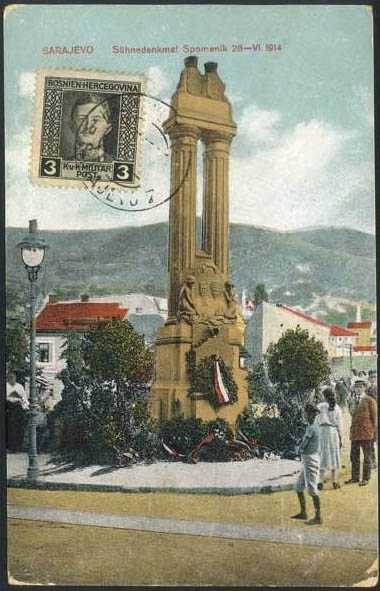
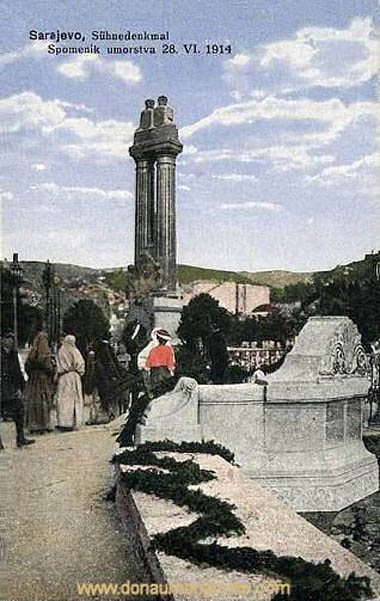
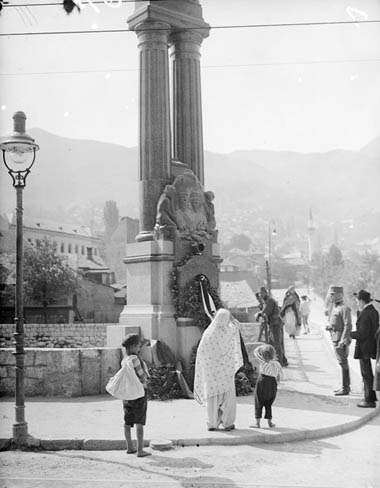
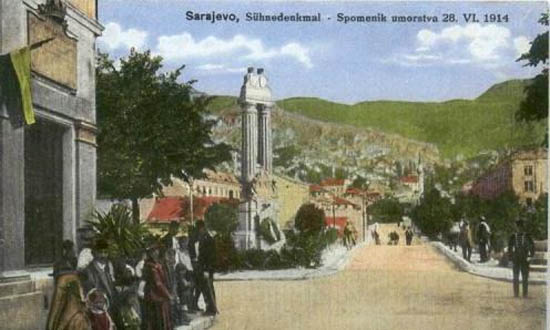
And this was just the beginning. Pater Puntigam began collecting more tribute to erect even larger memorial buildings to the princely couple: a huge Neo-Romanesque church in memory of Franz Ferdinand, and a youth home named for Duchess Sophie. Both were designed by Jenő Bory. The first three million golden crowns were collected, and Bory was already involved in the execution, when the Monarchy was forced to armistice, and then to retire from Sarajevo. The church was never realized. However, Jenő Bory recalled to have been inspired by it for his own home and studio in Székesfehérvár, the famous Bory Castle. The Serbian troops marching in Sarajevo removed both memorial plaques and the monument. Only the arched bench remained in the site, as an apparently innocent abbreviation of the story, which, however, spoke volumes to the initiates.
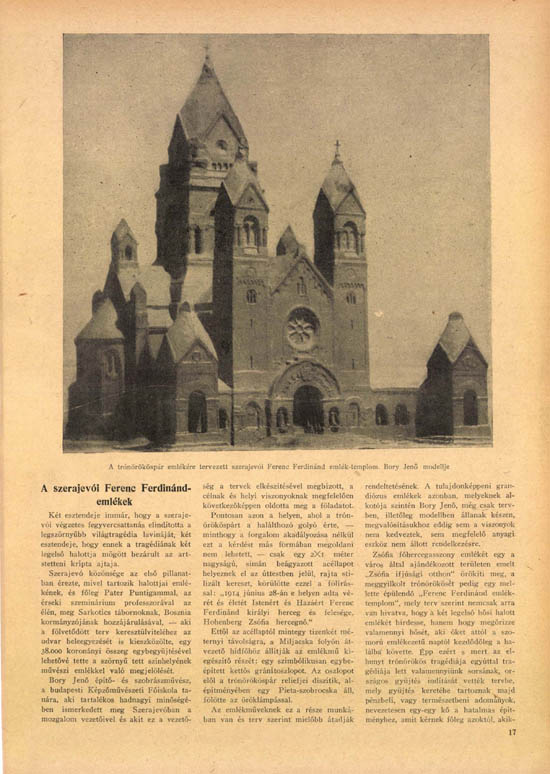 The model of the Franz Ferdinand memorial church, and a summary of Jenő Bory’s other monumental designs in Sarajevo. Új Idők, 1916/2, 21-22.
The model of the Franz Ferdinand memorial church, and a summary of Jenő Bory’s other monumental designs in Sarajevo. Új Idők, 1916/2, 21-22.But the story is not over yet. It turned out that the original bronze relief of the monument also survived the stormy century in the cellar of the museum. In 2001, it was proposed in the City Council to restore the columns, and set it up in its original location. For the time being, they erected a plexi plate at the memorial site, with a small drawing of the original sculpture, and a historical explanation.
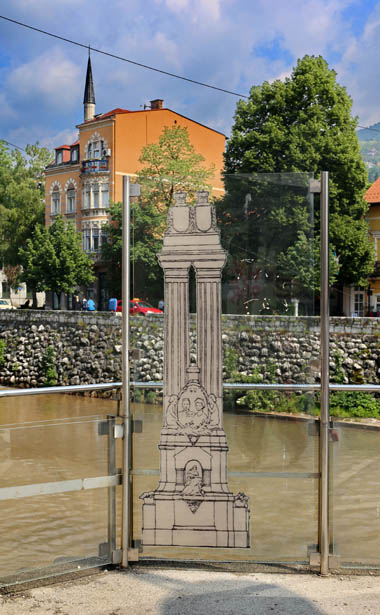
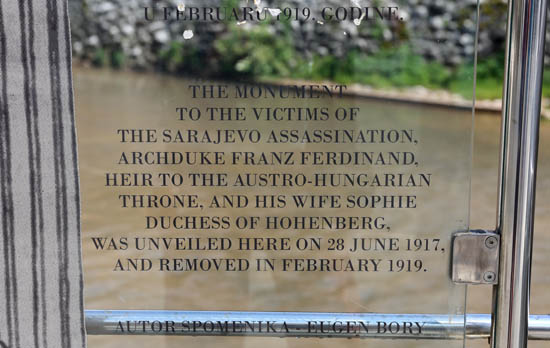
All this fits well with the new conception of Bosnian history outlined in recent decades, the three pillars of which are the independent medieval Bosnian kingdom, the rich culture and tolerance of Ottoman Sarajevo, and the Austro-Hungarian era of economic and intellectual revival. The public buildings and achievements of Austrian times are emphasized throughout the city. The former Young Bosnia Museum has been converted into a museum presenting the Austro-Hungarian Golden Age in Bosnia. At the centenary ceremony in Sarajevo, the Vienna Philharmonic Orchestra played Haydn’s Imperial Hymn. The epoch of Austria Felix has become a new zero point for Bosnian history. The monument of the assassination stood in the service of a new myth.
